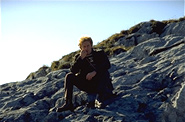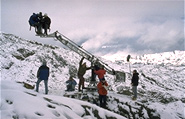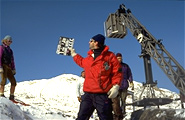A Glance into the Distance
Is a Glimpse into Oneself
Excerpts from an interview with Christian Wagner by Guido Wenzl for his documentary The Thirty-Two Points of the Wind Rose on the shooting of Wagner‘s TRANSATLANTIS.
TRANSATLANTIS describes a successful physicist‘s attempt to realize
his unfulfilled dreams. What function do the dream sequences in the film
have?
The film involves reality and mythical knowledge, dreams and visions.
All the dream sequences in the film have clearly defined functions. For
example, the sequence with the raft floating against the current towards
the source of the river is central to the film and corresponds to the
process that Neuffer himself undergoes. I would not have wanted to make
TRANSATLANTIS without this element of surreality, without the dreams.
As in your previous film, WALLER‘S LAST TRIP, one characteristic
of your method of working is the way you „reconnoitre“ your
sets and locations by walking about them.
I write my screenplays only when I know the main locations like the back
of my hand. I was constantly wandering around the plateau that is featured
in the film, for example. In the end, I knew exactly from which point
every scene would be shot. This close acquaintance with a location and
with the world in which the characters of a film move and act is important
to me and is related to my perception of the world. I have known Lake
Reschen, for example, with the church tower rising out of the water, since
my earliest childhood. It‘s a remarkable image, and it formed part
of my vision of Atlantis from the very beginning: something that has gone
down beneath the waves and risen up again.
The „Gottesacker“ plateau in the Upper Allgäu in south
Germany is about 6,500 feet above sea level. To use it as a film location
required special logistics. A camp had to be set up with tents to accommodate
people overnight, and everything had to be carried up on foot.
Yes, it required an enormous effort, and all the more so in Tibet. But
even with the most careful organization, one is still at the mercy of
nature. For example, the sea of mist that Neuffer sees in the mountains
of the Allgäu occurs on only a few mornings of the year in autumn,
and it vanishes completely after a while as if it had never been there.
Capturing this unusual atmosphere with the camera at just the right moment
is largely a matter of luck. It could easily have happened that we were
in Nepal or Tibet on precisely those days. We would then have had to wait
till the following autumn.
The film tries to find answers in the form of visual images, rather
than words. Certain vital scenes were quite complex in terms of shooting.
Did you consider alternative ways of realizing these images in a simpler
form?
The most important sequence of the film had to be shot at a height of
6,500 feet in most difficult, rocky terrain. The vision had to be realized
there. Certain intense images that, I‘m inclined to say, are almost
an obsession, tend to haunt me until I can banish them onto film.
Then why was it necessary to go on location to Nepal and Tibet as
well?
The story and its structure required that Neuffer should enter an absolutely
barren world at the end. Before he reaches the lake in the Himalayas with
Nele, there is a moment of complete stillness. Then, after their arrest,
they are driven in a Chinese truck through a bare landscape with ruins
somewhere in Tibet: an empty world, nothing but destruction, the reversal
of civilization. The pictures represent not only Tibet. They are a metaphor
for „Nomadslandt“, for TRANSATLANTIS.
Was it difficult to obtain permission to work in Tibet? This seems
to be one of the first foreign feature films ever shot there.
After about two months of research, it slowly dawned on me how I might
manage it. When I started working on the project a lot of people said
to me: „You‘ll never be able to shoot it in Tibet. Get that
out of your head!“ Of course I looked round for alternatives. But
a bare landscape like that, from which everything seems to have been drained,
just doesn‘t exist elsewhere. You really have to go to Tibet to find
that incredible light up there on the high plateau.
The film begins 500 feet below ground and ends up at a height of 17,000
feet above sea level. Isn‘t it a tremendous exertion to set up a
camera and all the other equipment in high-altitude regions like that?
The air is extremely thin there. Every movement is an enormous effort
for the actors and the crew. You have to think twice before you change
a location or even a camera position. But that was part and parcel of
this film. Every member of the team had to endure these physical and psychological
strains. It was a borderline situation for me, too, in more senses than
one. When we were shooting close to the Chinese border, the nervous tension
was very, very great. Time was pressing. We never knew exactly how long
we could carry on shooting. An army officer might come along any minute
and say: „What are you doing here? Stop that at once!“ It calls
for enormous concentration, speed and efficiency.
To reach one location in the Dolpo region in west Nepal, you had to
undertake a 6-day journey with a team of 20 people and 70 sherpas. Did
you want to show the team what it meant to „reconnoitre“ a location
on foot, or was it a matter of economic constraints, adhering to a DM
3.5 million budget, that forced you to keep transport costs to a minimum?
We certainly didn‘t save any money that way. We undertook this trek
mainly for reasons intrinsic to the story, but also to become acclimatized
to the altitude. The crucial question is whether something is absolutely
essential or not. Sometimes outward situations can help to create a state
of inner concentration, a momentum that can be felt in the shooting of
certain scenes.
Admittedly, Daniel Olbrychski is of the opinion that he can reproduce
this at any time through acting technique. He is, without question, an
outstanding actor, but I don‘t think you can simply re-create the
physical experience visible in his face after a 6-day trek simply with
the resources of an actor. It starts with the stubble on your chin and
the wrinkles in your face. And I would be reluctant to forgo these aspects.
The experience of having trekked in the Himalayas is essential to the
story. When you get up in the morning you feel that you have slept in
a sleeping bag and not on a spring mattress. You have to wash yourself
in a lake or a river, and you feel how cold it is. Your hair is different.
You‘re covered in dust.
The destination of this trek was the remote Lake Phoksundo in the
Dolpo region in Nepal.
Phoksundo, the deepest lake in the Himalayas, possesses a strange magic.
When we came over the crest of the hill and saw it stretching before us
it looked quite ordinary and peculiarly pale blue in colour. At first
we were all a bit disappointed. The initial reaction was: „Is that
what we‘ve tramped all this way up here for?“ I felt just the
same. My recollection of the lake was quite different, as were the photos
I had made. But within an hour the wind and the light changed, and the
lake was again sparkling and beautiful.
The receding sea of mist is reminiscent of paintings by Caspar David
Friedrich. Neuffer has his vision on a mountain, a place of inner exaltation.
In this respect, TRANSATLANTIS has something in common with Romanticism.
Of course there is an allusion to Caspar David Friedrich‘s Wanderer
in the Mist in TRANSATLANTIS; but the sea of mist is first and foremost
a bold, central image from my childhood. Anyone who has witnessed this
phenomenon in the mountains will know what I am talking about. The mountain
peaks really rise up like little islands from the mist.

Another picture, however, had en even stronger influence on me than those
of Caspar David Friedrich, whose figures are also often depicted gazing
at the distant horizon. The picture, Expectation by Richard Oelze, hangs
in the Museum of Modern Art in New York. One sees a group of people with
their backs turned to the observer. The glance into the distance is a
glimpse into oneself. Expectation can be seen as an overall theme of TRANSATLANTIS;
for Neuffer finds himself precisely in this state of expectation.
The film has to do with a basic human situation: we are always expecting
something to happen and believe our lives will be transformed into something
special. We don‘t know what, but we cherish the hope that one day
our lives will be crowned by an all-consuming love, a great career, lots
of money, happiness or fortune, or whatever else people dream of. It is
a vital principle, I believe. At the beginning of the film, Neuffer returns
to the Allgäu and sees a strange group of people standing on a hill:
in „expectation“. This motif occurs three times in the film,
forming a kind of triptych. Even in Tibet one finds a similar group of
nomads. Something else is in store for them, though. They are arrested,
escorted to lorries and driven away...

At CERN, European scientists are making a tremendous effort to simulate
the original big bang. Neuffer, the physicist, succumbs to other forces
that drag him out of his research centre back to his home in the Allgäu
and then into the Himalayas. Would a man really sacrifice his career to
undertake such a venture?
In Neuffer‘s case, the vision of an Atlantis that has not gone down
beneath the waves must be seen as a metaphor for another search: the search
for a personal dream, for a lost utopia. He is constantly tormented by
doubts that cause him to question the purpose of life or the path he is
pursuing. From the initial agony into which he is plunged - the sense
of mourning at his separation from the people and things that have been
dear to him in his life so far - something new develops. It is also a
question of how personal interest affects our insights and search for
the truth: the police inspector wants to solve a murder; Neuffer wants
to unravel his dream.
I wished to portray a person who is highly successful in his career, but
who is suddenly confronted with the basic questions of life. The process
is certainly intensified by the death of Neuffer‘s mother. If you
look at the film closely, you will see that it has a seam or hinge about
the central section: the sea of mist, which appears twice. Neuffer‘s
mother dies after the first appearance of the mist, i.e. within the visionary
section of the film. In other words, her death might be simply a figment
of his imagination, an expression of his fear of her death; and he pictures
to himself the consequences this would have.

A scientist leaves his wife, buries himself in the past, and sets
out on an adventure with a young girl. A straightforward case of someone
with a mid-life crisis?
That is not the subject of the film. Regardless of a person‘s situation
in life, whether one‘s at the pinnacle of one‘s career or not,
whether one‘s happily or not so happily married, whether one‘s
rich or poor, anyone can suddenly find himself in a position like this,
at a crossroads in life. What are the things that really concern me inwardly?
What do I really want to achieve in life? Are the things I‘m doing,
is my way of life really what I want? That might be the explosive force
of a story like this; and it should strike a chord in everyone. It‘s
something we‘re all concerned with, if we don‘t dismiss the
subject from our thoughts.
A scientist stranded with his vision in an archaic desert landscape:
is he a failure or a purged and wiser man?
I thought about the ending for a long time. Curiously enough, everyone
who has had anything to do with the film has his or her own interpretation
of the end. Viewers will have to supply their own conclusion, too. It
is a confusion of the senses of a positive kind. The audience leaves the
theatre neither with a happy end nor with a tragedy in their hearts. Everyone
has to find his own solution. What did this man really do? What would
one have done in Neuffer‘s place?
Ultimately, Neuffer finds himself stranded somewhat mysteriously on a
border on account of a strange wrist-watch. In abstract terms, he reaches
a point where he can go no further. He reaches the limits of scientific
thought, which he is unable to abandon. He then finds himself imprisoned.
That is why he is portrayed as so successful and smart at the beginning.
The figure then changes little by little, until, at the end, Neuffer is
a completely different person in the Himalayas, rough and dishevelled.
You have to let yourself be borne along by certain moods, images and statements
in TRANSATLANTIS, and then observe what happens within yourself. I have
been involved with this story for five or six years now: a man‘s
desperate search for meaning and purpose and for traces of his own identity.
A more concrete solution is not possible at present. Maybe it‘s better
to ask the right questions than to give the wrong answers.